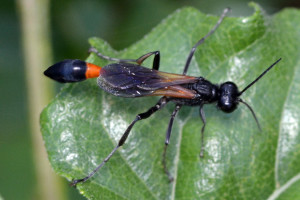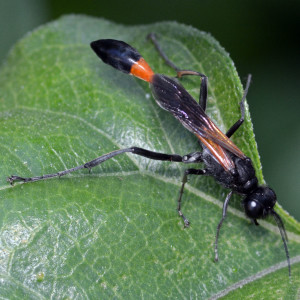It’s been a hot, dry, and windy March leading up to the Ides this year. Not great for photographing insects. But one evening as I was dragged out into the back yard by my soon-to-be 4-year old, I saw a large, slow-moving wasp. I ran back inside to grab my camera and was able to get a couple of shots in the gloaming; enough to capture the bicolored wings of the hunter wasp Ammophila pictipennis.

These solitary (nonsocial) wasps are in the family Sphecidae (hunter wasps). They’re large, up to an inch and a half long, but so slender (the group is sometimes referred to as “thread-waisted wasps”) and so slow-moving that they don’t inspire the kind of fear that the stouter, more angry-sounding wasps in the social wasp group Vespidae (yellowjackets, hornets, etc.) can. Those social wasps with their large, protein-rich resources in their sometimes-conspicuous nests are much more tempting targets for large mammalian predators like humans (and bears and skunks and so on), so those wasps have developed a much more fearsome stinging defense mechanism. Solitary wasps, being the sole provider for any potential offspring, can’t afford to lose a fight, so they don’t engage in them, even to defend their nest. Some solitary wasps can’t even sting.
But these ladies are no slouches. The group is known as hunter wasps for a reason: their slow-moving flight allows them plenty of time to search for their prey (spiders, caterpillars, and grasshoppers), which they will capture and bring back to their nest to allow their larvae to feed on the paralyzed but living host. They have long legs with prominent spurs that presumably help them maneuver their prey back to the nest:

They also have rather large mandibles, which enables these solitary ground nesters to excavate the holes in sandy areas that serve as their nests. They also use these large chompers to help conceal the entrance with pebbles and sand. They even—tool use, people!—use pebbles to pound the sand flat around the entrance area. Related species of wasps are the mud daubers, who layer up bits of mud (frequently on a wall or eave) rather than excavating in the soil.
I have yet to witness a predation event, but there are several photos around the web that show these ladies in action.
Etymology
The genus name, Ammophila, means sand loving (from the Greek roots ammo-, “sand,” and philo, “loving”). Appropriate, as that’s where they build their homes. And this particular species, A. pictipennis, was named for its distinctively colored wings (from Latin picto-, “painted,” and penna, “wing”).
References
bugguide.net. Species Ammophila pictipennis. Available at http://bugguide.net/node/view/7863.
Deyrup, M., Kenney, E., and Emmel, T. (2000). Florida’s Fabulous Insects. Tampa: World Publications.
Grissell, E. (2010). Bees, Wasps, and Ants: The Indispensable Role of Hymenoptera in the Garden. Portland: Timber Press.
